NASA WALLOPS FLIGHT FACILITY, VA – An Orbital Sciences Corp. commercial Antares rocket was given the GO for its first night launch on Oct. 27, following a launch readiness review on Sunday, Oct. 26, between managers from Orbital Sciences Corp. of Dulles, Virginia, and NASA.
The rocket was rolled to the launch pad and erected. Technicians are putting the final touches on the rocket to prepare it for flight to the International Space Station (ISS).
NASA and Orbital Sciences are targeting Antares for blastoff at 6:45 p.m. EDT on Oct. 27 from beachside Launch Pad 0A at the Mid-Atlantic Regional Spaceport (MARS) at NASA Wallops Island Flight Facility on Virginia’s eastern shore.
There is a 10 minute launch window to get Antares off the ground as the launch pad moves into the plane of the space stations orbit. The slightly longer launch window is due to the extra thrust available from using a new, more powerful ATK built upper stage engine.
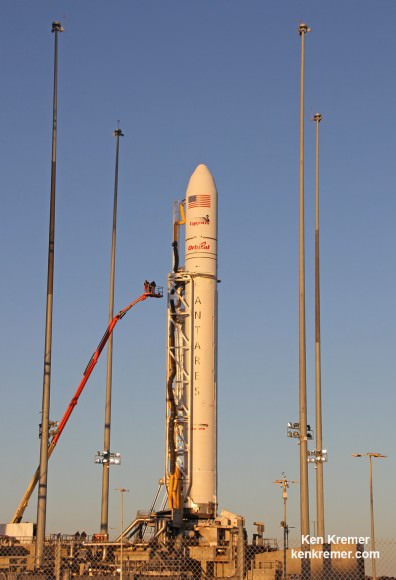
The rare spectacle of a night launch within view of tens of millions could WOW hordes of US East Coast residents in densely populated areas up and down the Atlantic shoreline – weather permitting.
The current forecast calls for an almost unheard of 98% chance of favorable weather conditions at launch time.
Depending on local weather conditions, the Antares blastoff will be visible along much of the US eastern seaboard – stretching from Maine to South Carolina.
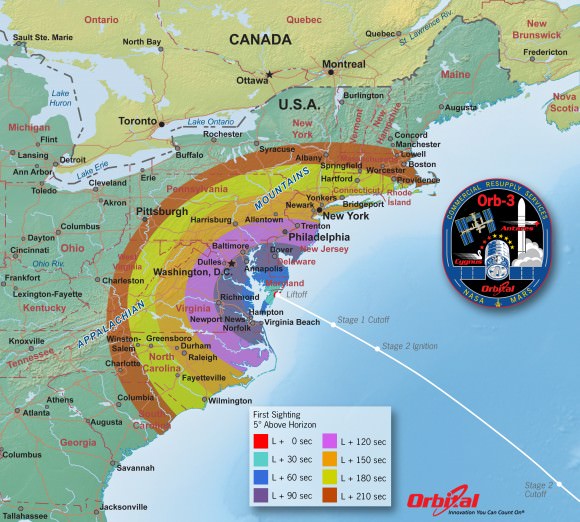
For precise viewing locations and sighting times, see the collection of detailed maps and trajectory graphics courtesy of Orbital Sciences and NASA in my prior story with a complete viewing guide on “How to See the Antares Launch.”
Antares is carrying Orbital’s privately developed Cygnus pressurized cargo freighter loaded with nearly 5000 pounds (2200 kg) of science experiments, research instruments, crew provisions, spare parts, spacewalk and computer equipment and gear on a critical resupply mission dubbed Orb-3 bound for the International Space Station (ISS).
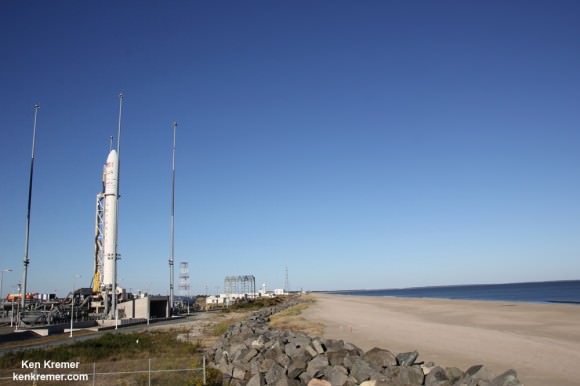
This is the heaviest cargo load yet lofted by a Cygnus. Some 800 pounds additional cargo is loaded on board compared to earlier flights, that’s enabled by using the more powerful ATK CASTOR 30XL second stage for the first time.
Research gear and experiments account for about 1600 pounds (720 kg), or about one third of Cygnus total cargo load.
Among the items aboard are 32 cubesats and deployers, a 6000 psi high pressure replacement nitrogen tank needed for spacewalks from the Quest airlock, experiments enabling the first space-based observations of meteors entering Earth’s atmosphere, determination of how blood flows from the brain to the heart in the absence of gravity, investigations on the impact of space travel on both the human immune system and an individual’s microbiome, the collection of microbes that live in and on the human body, and student science investigations from the SSEP/NCESSE.
“There is nothing more exciting than spaceflight,” said Frank Culbertson, Orbital’s executive vice president of the advanced programs group, at a pre-launch briefing at NASA Wallops.
“It is important to inspire the next generation of scientists. We need to keep the kids inspired to study math and science and keep going back to space. If we stop going to space, it will be very hard to restart.”
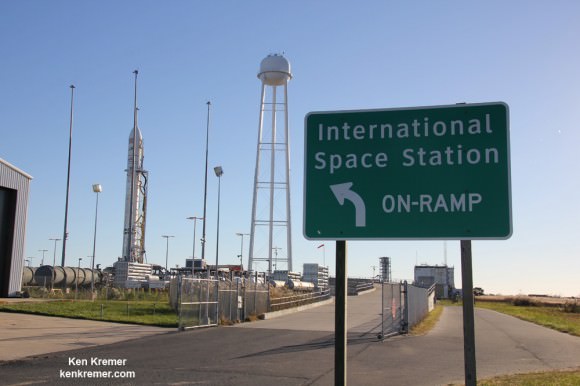
This Cygnus resupply module, dubbed “SS Deke Slayton,” honors one of America’s original Mercury 7 astronauts, Donald “Deke” K. Slayton. He flew on the Apollo-Soyuz Test Project mission in 1975 and championed commercial space endeavors after retiring from NASA in 1982. Slayton passed away in 1993.
The Orbital-3, or Orb-3, mission is the third of eight cargo resupply missions to the ISS through 2016 under the NASA Commercial Resupply Services (CRS) contract award valued at $1.9 Billion.
Orbital Sciences is under contract to deliver 20,000 kilograms of research experiments, crew provisions, spare parts and hardware for the eight ISS flight.
NASA Television will broadcast live coverage of the launch, including pre- and post-launch briefings and arrival at the station. Launch coverage begins at 5:45 p.m. EDT.
NASA will broadcast the Antares launch live on NASA TV starting at 5:45 p.m. Monday – http://www.nasa.gov/nasatv
You can also watch the pre- and post launch briefings on Monday on NASA TV.
Of course the absolute best viewing will be locally in the mid-Atlantic region closest to Wallops Island.
Locally at Wallops you’ll get a magnificent view and hear the rockets thunder at the NASA Wallops Visitor Center or other local spots around the Chincoteague National Wildlife Refuge area.
For more information about the Wallops Visitors Center, including directions, see: http://www.nasa.gov/centers/wallops/visitorcenter
Watch here for Ken’s onsite reporting direct from NASA Wallops.
Stay tuned here for Ken’s continuing Earth and Planetary science and human spaceflight news.
…………….
Learn more about Commercial Space, Orion and NASA Human and Robotic Spaceflight at Ken’s upcoming presentations:
Oct 27/28: “Antares/Cygnus ISS Rocket Launch from Virginia”; Rodeway Inn, Chincoteague, VA

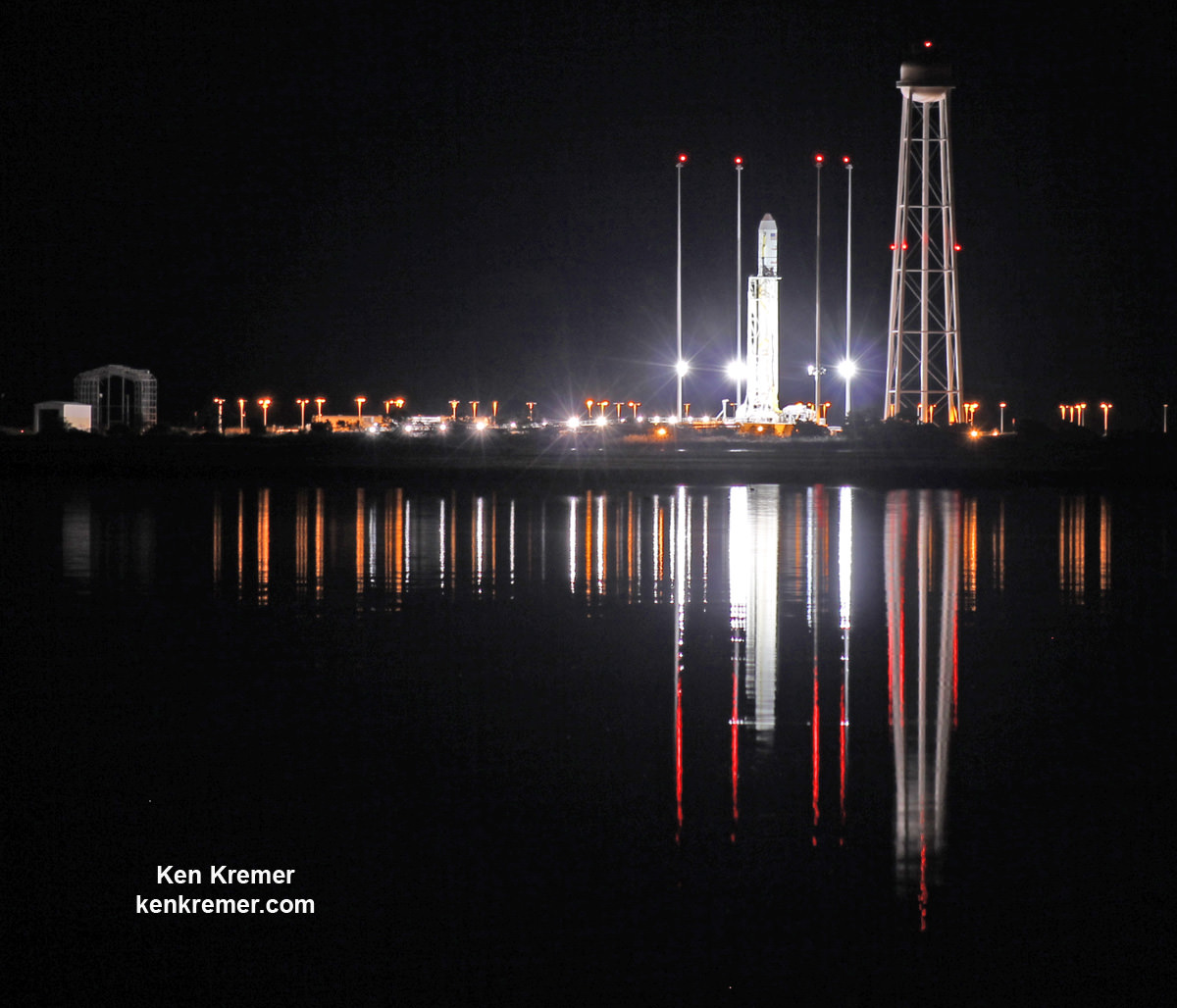
Monday October 27th 4 pm PDT. Monday’s launch attempt scrubbed due to ship present in restricted area. Possible attempt on Tuesday?